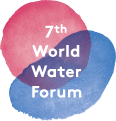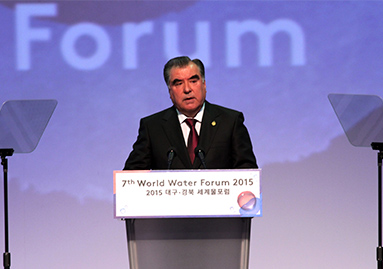Statement of the President of the Republic of Tajikistan H.E. Mr. Emomali Rahmon at the 7th World Water Forum (Daegu, 12 April 2015)

Dear Mr. Chairman,
Dear participants of the Forum,
Ladies and gentlemen,
First of all, let me express my sincere gratitude to the Government of the Republic of Korea for invitation to participate in such an important global water event as well as for creation of excellent conditions, and kind hospitality.
The theme of the current Forum – “Water for our future”, undoubtedly, is in sync with the time and corresponds to the existing global tendencies for defining our future actions for the post-2015 period, in which water resources should be given a strategic place.
Tajikistan is the initiator of a number of vital “water” resolutions of the UN General Assembly, and two initiatives – the International Decade for Action "Water for Life", 2005-2015 and the International Year of Water Cooperation, 2013 – were declared by me for the first time at the water forums – at the 3rd Forum in Kyoto and within the framework of the 5th Forum in Istanbul.
I am confident that the current Forum will also become a platform for new initiatives and ideas, aimed at solving water problems for our common safe future.

Dear participants of the Forum,
Certain progress has been achieved in the framework of the Millennium Development Goals, nevertheless the modern global challenges suggest hardly optimistic expectations. According to the World Water Development Report presented in March of this year already in 2030 more than 40% of the world population will face water shortage, and in 2050, when the world population exceeds 9.0 billion, water shortage will be felt even more intensely.
We share the view that it is necessary to implement urgent steps directed at the real actions. The analysis shows that our actions are mostly oriented on investments in the so called “soft” components, while the main role in this process is played by infrastructural projects.
Another important moment of our future actions should be orientation on the “green” growth, where water resources as a renewable energy source also should occupy an important place. Today the share of hydropower makes up abound 20% of the world’s electric energy production, while only about 45% of the economically profitable hydropower potential is used. At the same time 1.3 billion people in the world do not have access to electric energy and about 2.6 billion people use solid fuel (biomass) to prepare food.
Agriculture nowadays consumes about 70% of the world’s exploited amount of freshwater and in the developing countries this indicator reaches 90%. By 2050 agriculture is supposed to produce more than 60% of the world food stock, in developing countries – 100%. Inefficient use of water in agriculture has already led to salinization of 20% of world’s irrigable land.
An effective approach in his case is the “water-energy-food security nexus” that ensures the balanced account of interests of all important sectors.
Application of this approach undoubtedly creates a strong basis for ensuring the adequate water cooperation not only at the cross-sectoral level but also at the transboundary river basins. It is necessary to state that among existing 263 transboundary watercourses in 158 of them there are still remaining difficulties in defining concrete mechanisms for cooperative management and their realization.
Important measure for achieving water goals is sustainable financing. Unfortunately, financial and economic crises of the resent years undermine the countries’ efforts to provide relevant funding of the water sector. In this case creation of different national, regional and global funds and other initiatives for improvements in funding of the water sector are timely for assisting developing countries, including the least developed countries and the small island states, in addressing these issues.
Distinguished Ladies and Gentlemen,
Tajikistan occupies a leading position in the world in possession of water resources per capita. Around 60% of water resources in Central Asia are formed in the territory of the country.
However, deficiency of advanced infrastructure and limited financial capacity do not allow to fully use the water resources for the benefit of the economy of the country.
Despite the sufficient water resources today only 57% of the population of the country has access to the safe sources of fresh water and about 30% – to improved sanitation. The problem is particularly serious in rural areas where the fresh water supply makes up only about 40%, and improved sanitation – no more than 10%.
A serious problem for Tajikistan, where 93% of the territory are occupied by mountains, are water related natural disasters. Mudflows, landslide and floods annually cause great damage to the country’s economy, and sometimes, unfortunately, human casualties. For instance, for the last 5 years the total damage from floods in Tajikistan exceeded hundreds of millions of US dollars.
Another important challenge influencing the water resources is climate change that leads to intensive melting of glaciers. According to the experts, in the 20th century Tajikistan had lost more than 30% of the volume of its glaciers. An object of such concern is one of the World’s largest glaciers – the Fedchenko glacier situated in the center of Pamirs – which had retreated by 400 meters losing about 15 cubic km of its volume.
For ensuring its sustainable development Tajikistan, among other important tasks, has defined 3 top priorities: achievement of food security, energy security and overcoming the communication isolation. Achievement of food and energy security depends on the rational use of water and energy resources of the country, the increase of efficiency of existing systems and application of modern technologies in the water and energy sectors.
The achievement of sustainable development in Tajikistan is possible only through the rational development and use of water and energy resources and relevant financing of these sectors in the country.
Distinguished participants of the Forum,
I would like to draw your attention to the fact that the abovementioned water problems in Tajikistan are very typical for other countries of Central Asia as well.
High rates of population growth in the region (2.0-2.5%), as well as climate change have a negative impact on the condition of water resources and this problem is becoming more urgent from year to year.
Today natural flows of rivers in the region do not reach the Aral Sea and the economy of the region develops in conditions of increasing deficit of water. At present, the total water use is 130-150% in the Syrdarya river basin and 100-110% in the Amudarya river basin.
According to the exiting estimations the sufficiency of water supply per capita in the region would reach the critical level – less than 1.7 thousand cubic meters/year in 2030. In comparison, in 1960 this indication was about 6 thousand cubic meters/year per capita.
The next vital issue is the water supply to the agriculture. From year to year, the irrigation of more than 8.5 million ha of land in the region, in terms of variability of the hydrological cycle, increased frequency of dry years and drought, becomes more problematic. Irrigated agriculture uses more than 90% of the region's water resources, and accordingly, the consequences of climate change to water resources would be tangible in this very sector.
In this conditions, the rational use of water resources, especially through introduction of water-saving technologies, modernization of irrigation and drainage systems, new approaches for irrigation, adequate accounting of water resources, development and implementation of other adaptation measures are of vital importance.
Another problem that emerges from year to year is the issue of electric power supply in Central Asian countries. Despite the huge potential, especially renewable hydropower resources, some countries in the region in wintertime face electricity shortage. While existing hydropower potential of the region can cover by 3-4 times more the needs of the region in electric power, the share of hydropower in the total production is only about 25%. In this case, the existing hydropower is used only by 10%. For example, in Europe, this figure is about 70%, and in Switzerland - 90%.
In our opinion, the integrated approach in solving the issues of water and energy supply and food security is timely in our region. This approach contributes to the rational use of natural resources, considerable decrease in emission of carbon dioxide to the atmosphere, as well as to the “green” growth directed at the use of renewable energy sources.
Only mutually beneficial cooperation in terms of rational use of water resources will provide sustainable water supply to the population and countries of the region, improving the environment. It will also allow the countries of the region to have additional economic benefits, the volume of which, according to some estimation, would make up to 5% of regional GDP.
Dear Chairman,
Dear members of Forum,
This year the International Decade for Action “Water for Life”, 2005-2015 is being completed and in this regard it is necessary to conduct comprehensive assessment of the actions implemented during the decade, define the difficulties and problems in the process of implementation of the Decade’s goals, as well as plan the further actions in the post 2015 period.
Undoubtedly, the implementation of the International Decade for Actions “Water for Life” contributed to consolidation of our joint efforts at the local, national, regional and international levels in order to enhance measures in achievements of the water related goals.
However, the modern global challenges and threats, including the population growth, climate change, increase of natural hydro meteorological phenomena, water shortage and its low quality significantly influencing the poverty level, the increase of infectious diseases, child and maternal mortality, still require the mobilization of our efforts and relevant measures.
Therefore, today I would like to propose to announce the Second International Decade of Action under the motto “Water for Sustainable Development”. I am confident that by announcing of this decade of action the world community will continue the implementation of the indicated measures within the framework of the International Decade “Water for life”, enriching it with new measures and efforts for achievement of the Sustainable Development Goals. We count on the support of this proposal by the International community.
Dear Ladies and Gentlemen,
To conclude, I would like to remind that according to the UN General Assembly resolution entitled “International Decade for Action “Water for Life”, 2005-2015 and further efforts to achieve sustainable development of water resources” adopted last year in December, there will be held a High-Level International Conference on the implementation of the International Decade on 9-11 June 2015 in Dushanbe.
I believe that in the framework of the Dushanbe Conference with participation of the representatives of the UN member states, regional and international organizations, as well as NGOs and the private sector there will be conducted a comprehensive assessment of the implementation of the International Decade “Water for Life” and outlined the next steps for the achievement of sustainable development in the field of water resources.
Taking this opportunity, once again, on behalf of the Government of the Republic of Tajikistan I would like to invite all interested parties to participate in this international event and contribute to its success.
Thank you for attention!
